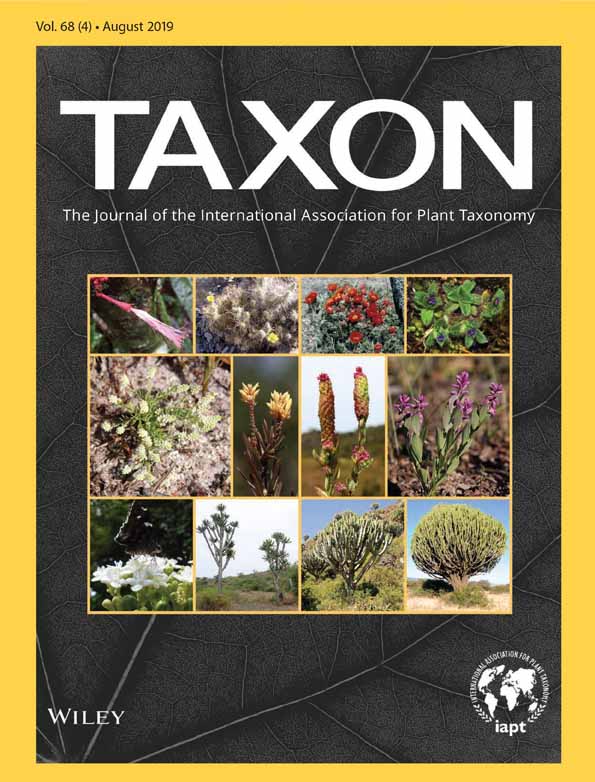(2709) Proposal to conserve the name Callistophytaceae against Emplectopteridaceae (Pteridospermopsida)
(2709) Callistophytaceae Stidd & J.W. Hall in Amer. J. Bot. 57: 835. 27 Aug 1970, nom. cons. prop.
Typus: Callistophyton Delev. & J. Morgan
(=) Emplectopteridaceae R.H. Wagner in Proc. Geol. Soc. London 1640: 150. 31 Mai 1967
Typus: Emplectopteris T. Halle
Callistophytaceae was established by Stidd & Hall (in Amer. J. Bot. 57: 835. 1970) based on structurally preserved plant fossils in coal balls from the Pennsylvanian of North America. Detailed investigations enabled a comprehensive understanding of the growth habit and reproductive biology of this group (Rothwell in Palaeontographica, Abt. B, Paläophytol. 151: 171–196. 1975, 173: 85–106. 1980), leading to the introduction of the order Callistophytales G.W. Rothwell (in Rev. Palaeobot. Palynol. 32: 118. 1981). The name-bringing genus Callistophyton Delev. & J. Morgan (in Palaeontographica, Abt. B, Paläophytol. 86: 17. 1954) was later recognized as the structurally preserved equivalent to the adpression taxon Dicksoniites plukenetii (Schloth. ex Sternb.) Sterzel (see Meyen in I. O. P. Newslett. 18: 5–6. 1982; Meyen & Lemoigne in Geobios (Lyon) 19: 93. 1986). The Callistophytaceae was also proven to be the oldest plant group with siphonogamous fertilization via a pollen tube (Rothwell in Science 175: 772–774. 1972). This wealth of detailed information makes the Callistophytaceae probably the best-known family of Paleozoic pteridosperms (e.g., Taylor & al., Paleobotany, ed. 2. 2009).
Current systematic-palaeobotanical treatments (e.g., Anderson & Anderson in Strelitzia. 20: 1–280. 2007; Seyfullah & Hilton in Pl. Syst. Evol. 279: 191–218. 2009) recognize Callistophytales as containing one additional, rather poorly circumscribed family, Emplectopteridaceae R.H. Wagner (in Proc. Geol. Soc. London 1640: 150. 1967), which is based on frond adpression fossils from the Permian of China (Halle in Palaeontol. Sin. 2: 1–136. 1927, in Bull. Geol. Soc. China 11: 301–306. 1932).
Since Callistophytaceae is based on structurally preserved coal-ball material and Emplectopteridaceae is based on compression fossils yielding gross morphological information only, the diagnoses of these families are not mutually exclusive but in most parts complementary. A conspicuous similarity in those features available for comparison is already stated by Halle (l.c. 1932: 302–303), who recognized the great resemblance of the type, Emplectopteris triangularis, to Dicksoniites plukenetii. Recent revisions of Halle's type material and additional specimens from the Permian of China also indicate close similarities between members of the two families (Seyfullah & Hilton, l.c. 2009, in Palaeontology 54: 287–382. 2011). Moreover, ongoing studies of exceptionally well-preserved material from the Permian of China (Backer & Kerp in Yang & al., Crit. Intervals Earth Hist.: 7. 2017) reveal new taxa that combine vegetative morphology typical for the Emplectopteridaceae with reproductive organs identical to those of Callistophytaceae. Hence, there is mounting evidence to suggest that these two families have to be united. Under strict provision of the Shenzhen Code (Turland & al. in Regnum Veg. 159. 2018), the legitimate name for this family would then be the senior Emplectopteridaceae R.H. Wagner, which is rarely used, broadly circumscribed, and its name-bringing genus poorly understood.
The name Callistophytaceae, by contrast, is widely used in the paleobotanical literature and also appears in general botanical and paleontological treatments (see, e.g., Meyen, Fundam. Palaeobot. 1987; Beck, Origin Evol. Gymnosperms: 218–272. 1988; Cleal in Benton, Fossil Record 2: 798–799. 1994; Kenrick & Crane, Origin Early Diversific. Land Pl. 1997; Taylor & al., l.c.). String searches for “Callistophytaceae” versus “Emplectopteridaceae” in several bibliographic databases performed on 18 March 2019 returned the following numbers of citations: in Scopus: 1 versus 0; in Web of Science: 4 versus 0; and in Google Scholar: 260 versus 8.
The conservation of a widely established family name against an earlier, but less desirable, name when the families involved are united goes back to the Montreal Code (Lanjouw & al. in Regnum Veg. 23. 1961); such conserved family names are now included in App. IIA of the Shenzhen Code. Accordingly, we propose that when Callistophytaceae is united with Emplectopteridaceae, the name Emplectopteridaceae be rejected in favor of Callistophytaceae in order to maintain nomenclatural stability.
Author Information
MB, https://orcid.org/0000-0002-9078-3736
HK, https://orcid.org/0000-0003-3683-4093
BB, https://orcid.org/0000-0002-2186-4970
Acknowledgements
We wish to thank John McNeill (Royal Botanic Garden, Edinburgh) and John Wiersema (Smithsonian Institution, Washington, D.C.) for their constructive comments and help in nomenclatural issues. Technical and financial support was granted by the National Natural Science Foundation of China (41872013 and 41530101), the Chinese Academy of Sciences (XDB18000000, XDB26000000), the Nanjing Institute for Geology and Palaeontology, and the German Research Foundation (DFG grants KE584/21-1 to HK and BO3131/1-1 to BB). This proposal is an outcome of the Chinese-German joint project “Late Palaeozoic Palaeobiology, Stratigraphy and Geochemistry”, funded by the Sino-German Center for Research Promotion (Beijing), a cooperation of the National Natural Science Foundation of China and the German Research Foundation.




